Scotland's Islands & Highlands Tour Diary
Day 3 : On the Isle of Islay
|
|
The Kildalton Cross, dating to the 8th century, on Islay |
Islay - the ancient home of the MacDonalds - Lords of the
Isles - is better known these days as being the home of
seven extraordinary distilleries.
Part
of an 11 day/page trip diary - click the links on the right
hand side for the other days in this diary. |
Jeanette and her husband Ken
were on our 2010 Scotland's Islands and Highlands Tour, and
Jeanette kept a detailed day by day diary of the tour.
She has very graciously allowed
it to be re-published here, so as to allow you an unvarnished
view into what the tour was all about.
The text is hers, which I've
respected and not changed apart from a few subheadings and extra paragraph
breaks and some Americanizations of her English spelling (they
are from New Zealand).
I've sourced the pictures and
their captions are also from me, not Jeanette.
You can follow along with her
narration by tracking the tour on this
tour
itinerary page and the linked Google maps.
I hope this will encourage you
to come on our
2011 Scotland's Islands and Highlands Tour.
Day 3 – Wednesday June 16th
2010 – On the Isle of Islay
Google Touring Map for the Day
I woke up at 7am after a
restless night on the very narrow bed. Breakfast at 8am when Ken
had a full Scottish breakfast again and I had fried eggs and
sausage. We shared a pot of hot chocolate while I tried a piece
of brown toast with their home made marmalade made with whisky,
it was yummy.
The bus left at 10am for the
25 minute drive to Finlaggan, the ancient seat of the Lords of
the Isles. We had to wait for a few minutes (until 10:30am) for
the exhibition centre to open where we had time for a quick look
around a very interesting and well laid out small exhibition.
|
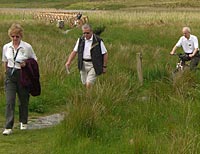
Diary author Jeanette, her husband Ken, and another
group member on bicycle bringing up the rear, all at
Finlaggan. |
We
then walked out to see the ruins on the small island where, in
the Middle Ages, the MacDonald's ruled the Hebrides and large
areas of the west coast of Scotland as Lords of the Isles. They
were descended from Somerled, a 12th century prince, and these
lords, the chiefs of Clan Donald, chose Finlaggan as their home
and the centre of their lordship, so that Islay is often
referred to as the Cradle of Clan Donald. The Lords of the Isles
ruled the islands and part of the west coast of Scotland, from
Kintyre to Lewis, virtually independent of royal control. The
heir to a strong Gaelic and Norse tradition, the Lord of the
Isles was one of the most powerful figures in the country with
the small islands in Loch Finlaggan a centre of symbolic and
administrative importance.
|
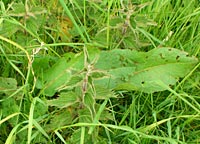
Stinging nettles are the leaves with pointy edges,
dock leaves are the rounded leaf plants. |
There were a number of
buildings that have been excavated on the island with
information panels describing the original use of the buildings.
We bought a book on Finlaggan (£3.00).
Hilda (originally from
England) identified some Stinging Nettle plants and then pointed
out Dock plants which always grow nearby as the Dock leaves are
a natural antidote to the sting from the nettles.
We were meant
to leave at 10:55am but we were not all onboard until 11:10am
with David saying 'This is NOT to happen again'.
We drove back to Bowmore to
collect the 3 remaining passengers then drove to Port Ellen past
a Malting Company who provide malting to distilleries who do not
want to make their own malting (germination of the barley). We
passed acres of peat fields and could see someone cutting peat
and putting it onto a wagon pulled by a tractor.
|
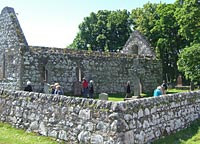
The lovely peaceful ruined church and cross at
Kildalton. |
From Port Ellen
we drove North along the coast to see the Kildalton Cross. It
was a lovely sunny day now as the clouds had cleared and there
was no wind. After passing the village of Ardbeg, we continued
on a narrow winding single track road with trees growing
overhead, scratching the roof of the coach. We arrived at the
ancient 8th century cross in an old church yard. It was 10 feet
high made of very weather resistant stone. Thanks to Jay for
getting us there safely as the church ruins and graveyard were
very interesting and worth the drive. There were graves as
recent as 1923 so families were still living in this area in
recent times. I took a photo of Jay beside the cross to prove to
him that he had made the journey.
|
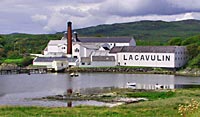
The Lagavulin Distillery. |
We left about 12:30pm and
stopped at the Ardbeg distillery for lunch in their cafe. We had
fun conversations with Jay, Malcolm and Ieva, sitting outside in
the sun. One of the Whisky writers, Jim Murray, believes this is
the best distillery in Scotland. On our way back towards Port
Ellen we stopped for photos at the Lagavulin distillery,
especially as they make Malcolm and David's favourite Whisky. We
later passed another distillery, the Laphroaig. David told us a
great story about the prohibition era in the USA. When most of
the distilleries in Scotland were going out of business (the USA
was their largest market), only one managed to sell their whisky
legally to the USA because it was marketed as a medication.
We drove back across the
peat plains. The road was very straight but very undulating as
it was built on the peat. Oren was very interested to see one of
the new micro jets sitting on the Port Ellen airport apron. Our
next stop was at Loch Gruinart RSPB (Royal Society for the
Protection of Birds) centre. It covers 4,000 acres of which 250
acres are salt marches. 50% of the world's Greenland White
Fronted Geese nest here. There have been over 24,000 geese on
the ground at one time. There are 24 species of butterflies and
dragonflies. We arrived about 2:25pm but did not see any birds
except a lot of black Crows and one lovely large colourful
Pheasant. David offered anyone who wanted to stay here instead
of going to the next distillery that Jay would come back for us
but as Ken and I were the only ones who were interested we
decided to stay with the group. After about 20 minutes, we
boarded the coach again and drove to the Bruichladdich
distillery where Ken and I were glad we had made the decision to
visit yet another distillery. This one was the best of the lot.
We were welcomed with a dram
of Octomore whisky, £87.00 a bottle. Ken and I shared a glass of
this extremely smoky (140 ppm) whisky and were fascinated to
find the flavour changed (actually improved) each time we added
a little bit of water (as told to by the Manager). I still said
it was not my favourite drink unless you added cream to it –
Baileys Irish Cream is whisky based. We were given a very
interesting tour of the distillery by the Manager, Duncan
McGillivray. The shaft of the Mash Tun broke last week and it
has to be specially manufactured in Glasgow. There is no
template or plans for it as it was made in 1881. The wooden Mill
is also very old made in 1930. When the water is put into the
Mash Tun they use a float in the tank connected to a string with
a weight on the other end. As the water level rises the weight
moves down showing them how much is present. They call this
their 'computer'. Their original washbacks were made of Canadian
Pine while their new one is made of Douglas Fir. They were
installing a new distiller to make Gin to get a quicker payback.
They fill their casks with
70% proof spirit in the hope that over the up to 40 years it
sits in the cask it will not drop below 40% proof. Below that
level it cannot be sold as Whisky. Most distilleries cask at
63.5% proof. They have their own bottling plant which is unusual
on the island. It can bottle 2,000 bottles per hour. They were
currently bottling 17 year old Rum from Trinidad which had been
held in special casks here for about 3 years. It then could be
sold as their own Rum.
|
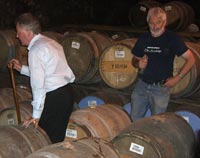
Ubermeister whisky guru Jim McEwan and
Bruichladdich's Distillery Manager Duncan McGillivray gave
us whisky samples straight out of the barrel. |
They were getting ready to
bottle their own 18 year old Whisky at 46% proof alcohol. We
went into the cask room where we met the Master Distiller, Jim
McEwan, who entertained us with wonderful stories of the
business and the staff. The company used to be owned by Jim Beam
Co who closed it but it was re-purchased in 2001. Now all
employees are shareholders. They sell some of their malt barley
to a perfume company. Duncan poured out a dram of whisky from
their 1997 cask. I was really enjoying it and thought I might be
able to finish it but while I was taking photos Duncan topped it
up again which was way too much for me. We next were given a
dram of 9 year old Guadalupe Rum which had been in a wine cask
for a year. Not as nice as the whisky.
|
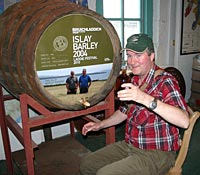
David filling his own bottle of whisky straight from
the barrel at Bruichladdich. |
By 5:15pm we left the cask
room and went back to the shop where Duncan poured out more
drams. Ken got a 16 year old whisky with a lighter smoky flavour.
I was getting very used to whisky by now so shared Ken's. We
were also given chocolates with whisky centers, yummy. We
finally said goodbye to Jim and Duncan after watching David
decant his own bottle of whisky from a special festival cask in
the shop and watched Duncan cork, cap and label it. It cost
David £55.
We left at 5:40pm to drive
back around the bay to Bowmore, which we could see from the
distillery. There were free ranging cows and heifers along the
road which made us slow down at times. We first stopped at the
Harbour Inn to drop off the people staying there, then up to the
Bowmore Hotel for the rest of us. We had an hour to get ready
for dinner at 7pm at the Harbour Inn. David had been very
gracious in giving 6 of us his booking for the evening at the
Harbour Inn. He was going to eat elsewhere with some of our
party. We walked to the Inn with Anne-Marie and Ted (she from
Switzerland and he from England and they now live in Arizona)
and met Billy Jo and Jeannette in the very pleasant lounge.
Ken and I enjoyed a glass of
Magners Cider in the lounge while we perused the menu and
ordered our meal. When the first course was ready we were called
to our table. Ken had Venison slices with a salad while I had
Haddock Chowder, both very nice. Ken then had local salmon and I
had Islay Scallops on black pudding slices and pea puree. I gave
the black pudding to Ken who was very pleased. The table shared
bowls of courgettes, carrots and potato.
The salmon was very
moist but not crisp on the skin as it was in the Indian
restaurant last night. My scallops were nice but not as large
and juicy as New Zealand scallops. Ken and I did not have
dessert but we stayed at the table while Jeannette, Billie-Jo
and Anne-Marie all had dessert. We all enjoyed each other's
company with lively conversation until, while waiting for
dessert to be delivered, a large group of Germans arrived taking
a set of tables right down one half of the small dining room. We
could not hear each other talk very well after that so we were
glad to leave when the desserts were finished (£60.85).
We were back at our hotel
about 9:30pm. Ken had a very sore tendon in the back of his
right foot making him hobble home. No idea how it happened. We
packed our bags for the morning then both had showers before
ringing Mum again in NZ. I had a nice chat with her then lights
out by midnight.
Read more in the rest of
Jeanette's Diary
See the links to each day
of the eleven day tour/trip diary at the top
right of this page.
|
If so, please donate to keep the website free and fund the addition of more articles like this. Any help is most appreciated - simply click below to securely send a contribution through a credit card and Paypal.
|
Originally published
7 Jan 2011, last update
30 May 2021
You may freely reproduce or distribute this article for noncommercial purposes as long as you give credit to me as original writer.
|

